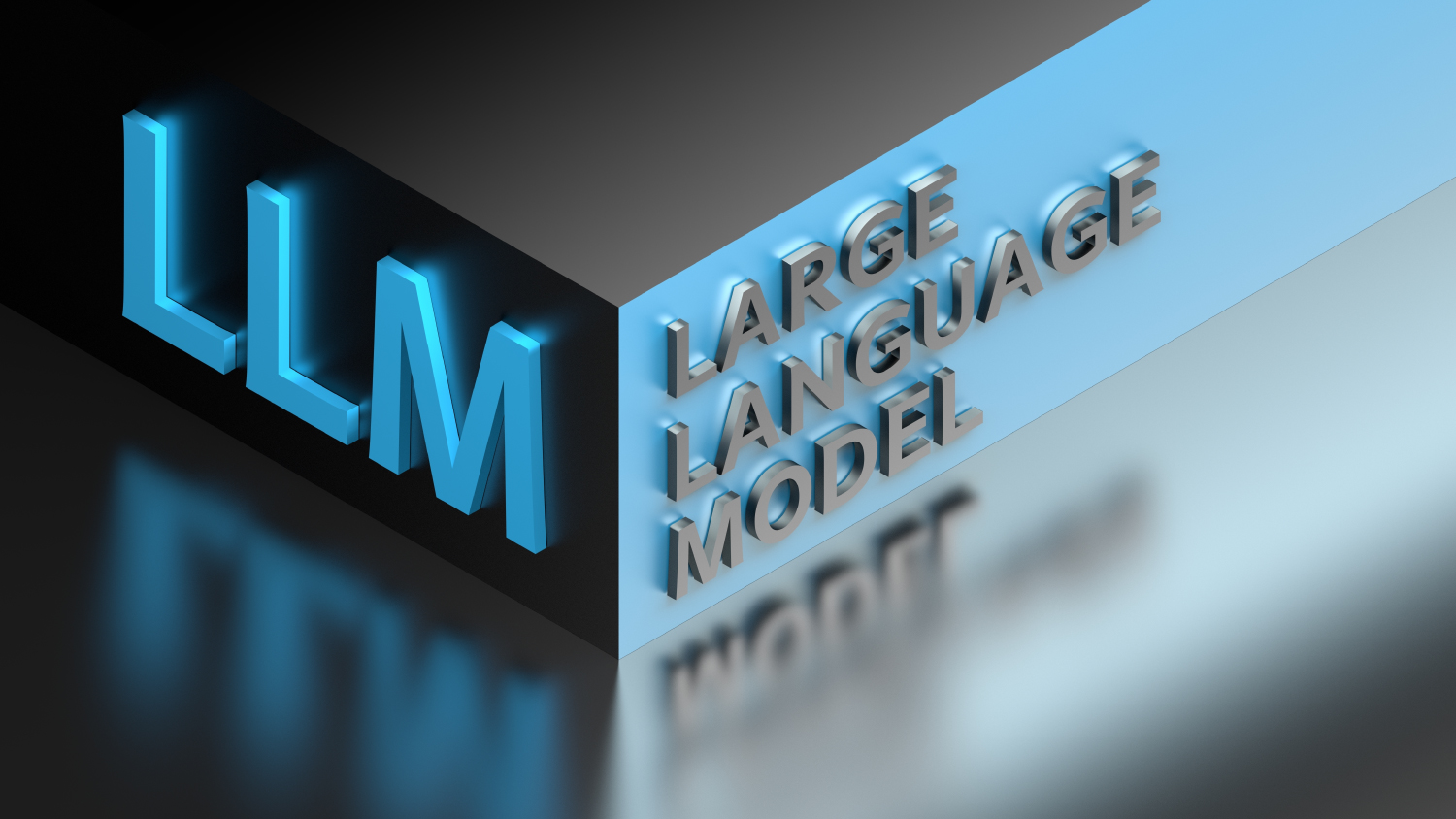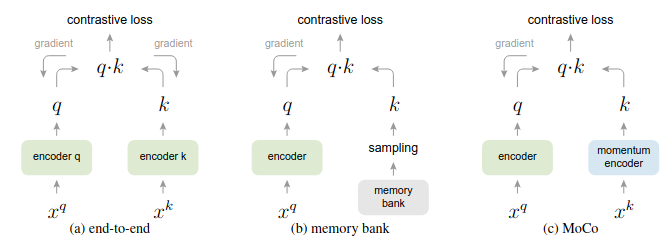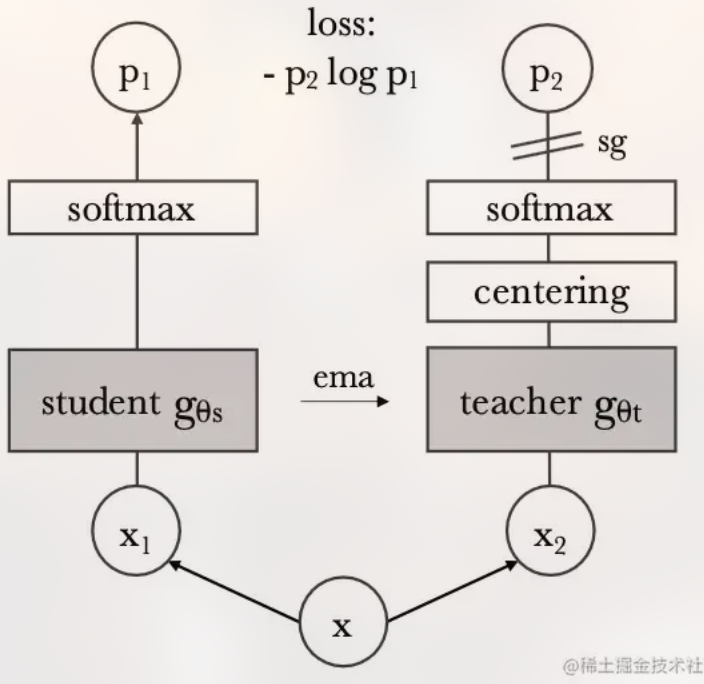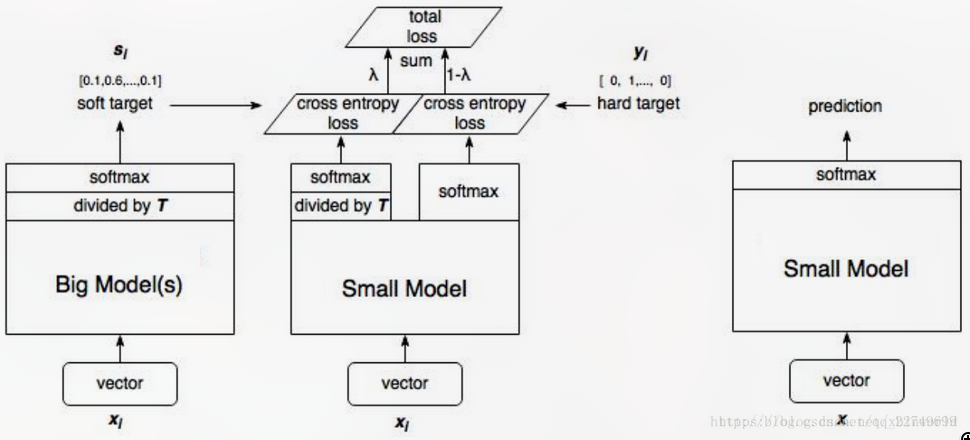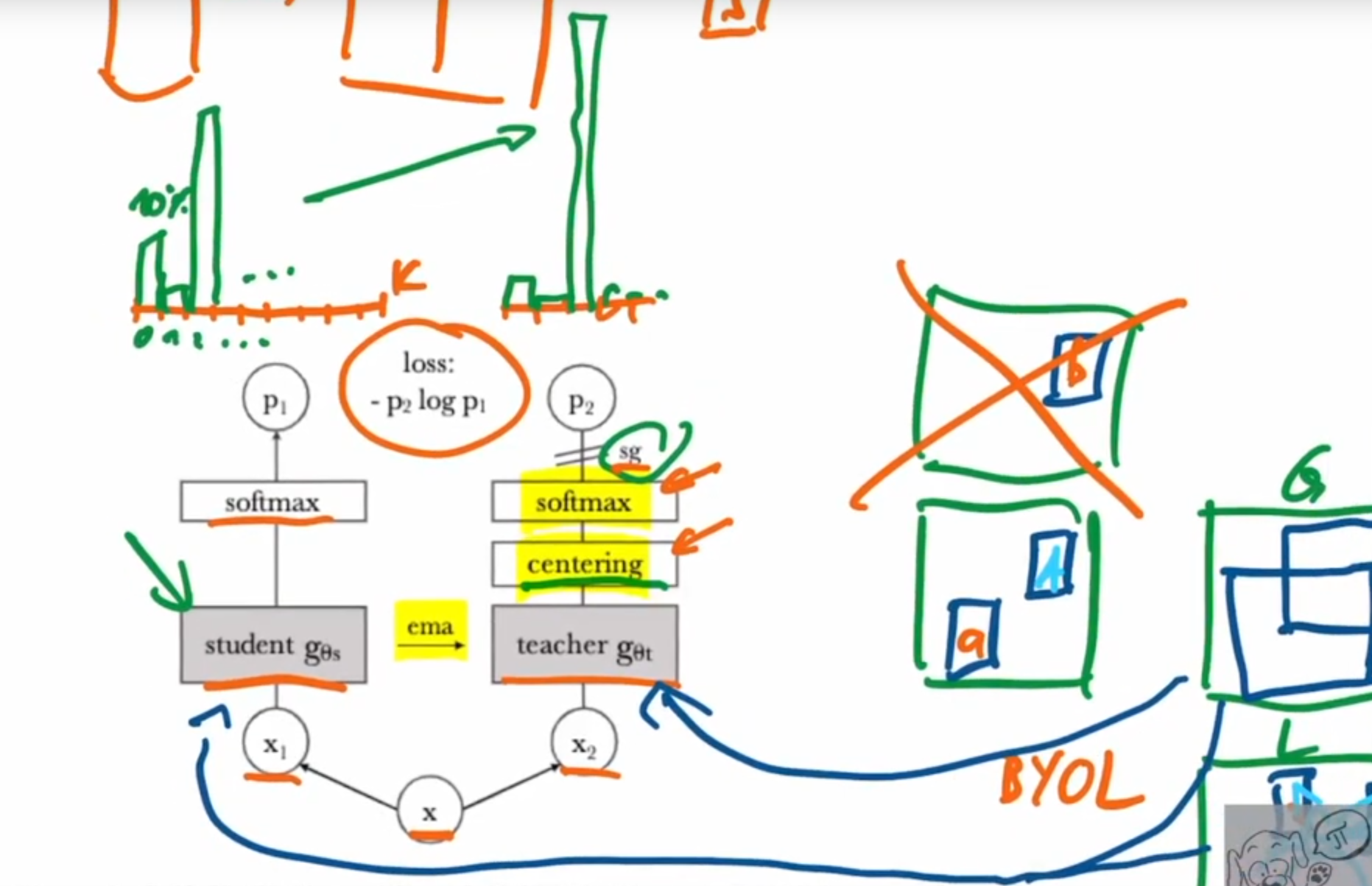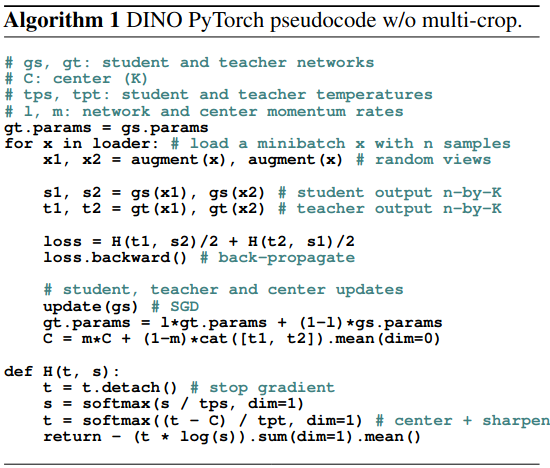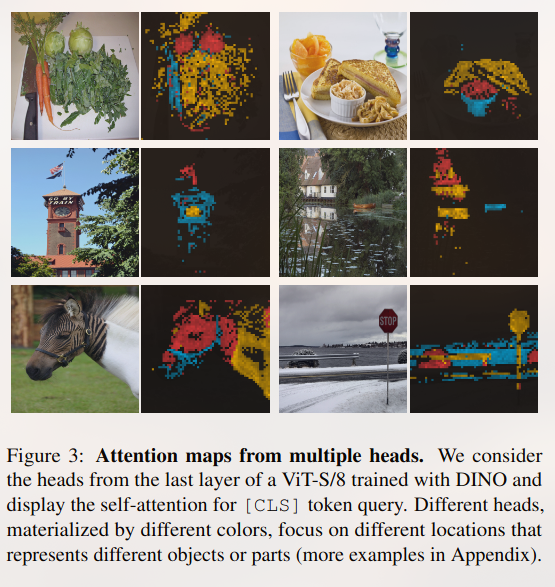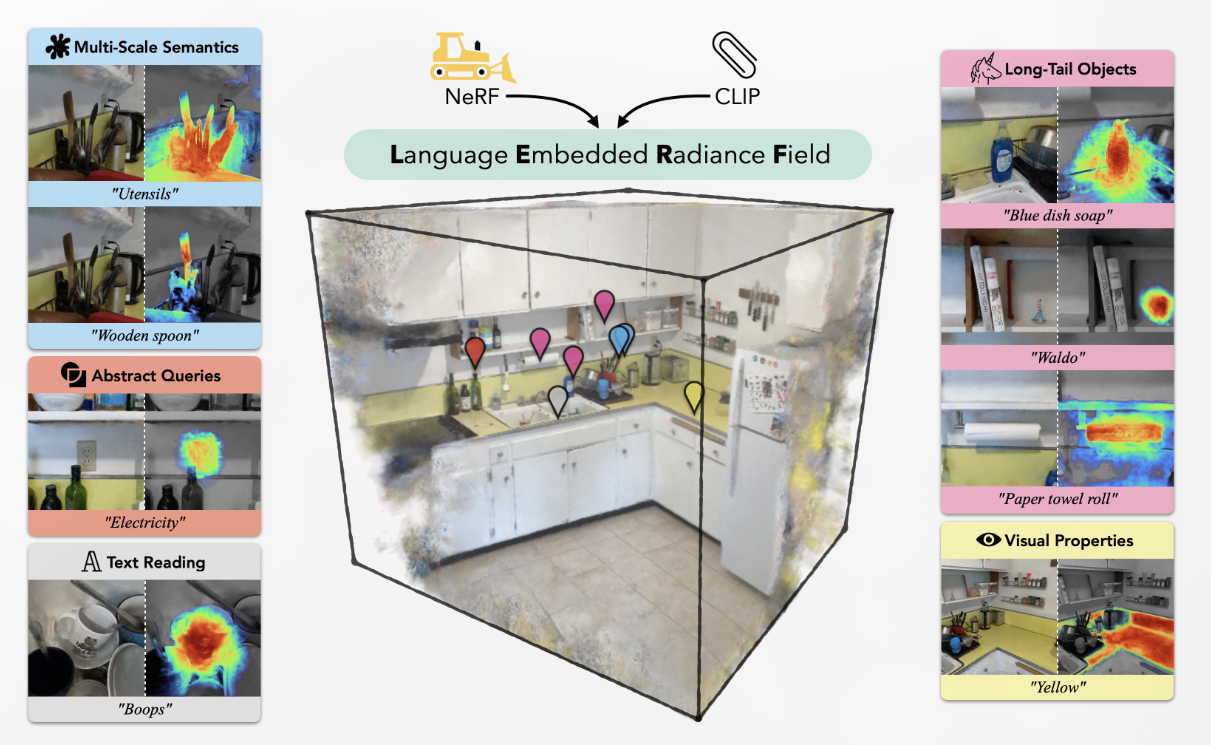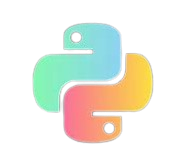
Momentum Contrast for Unsupervised Visual Representation Learning
左侧是query encoder,右侧为key encoder
## 是什么
通过无监督对比学习的方法(loss:InfoNCE)来学习图像的特征。
使用的pretext task是个体判别任务
伪代码:
1 | # f_q, f_k: encoder networks for query and key |
亮点
Dictionary as a queue
在使用key encoder(momentum encoder)创建负样本,并把encode过的负样本存在一个queue(FIFO)中方便后续对比时直接使用,每次训练都会使用一个新的mini batch,此时会将此mini batch中的样本encode之后加入queue并删除存在最久的那个mini batch的样本(因为考虑到最老的mini batch使用的encoder是最过时的,所以FIFO是非常合理的),这样可以有效控制负样本的数量,也就是公式中的K。
- 节省字典的计算开销
- 而且mini batch大小可以直接和负样本脱钩
Momentum update
因为负样本数量(字典/队列)很大,所以没办法给key encoder回传梯度,所以可以考虑把query encoder的参数直接复制给key encoder,但过快改变的key encoder会导致样本字典的特征不一致,所以使用动量更新的方式。
> queue这个字典越大,那么理论上这个m就需要越大,保证字典中key的一致性过往工作对比
a) 所有的样本都在一个 mini batch 里,两个encoder完全一致,也因此都可以回传梯度,keys也高度一致,但限制了字典的大小b)
只有一个编码器进行学习。Memory bank存下了所有样本的key。每当梯度回传后,会把memory bank被本次训练中被采样过的key使用新的encoder进行更新。
- 缺乏特帧一致性
- 需要训练一阵个epoch才能更新一遍memory bank
MoCo和memory bank 更接近,但是使用了queue dictionary和momentum update
AN IMAGE IS WORTH 16X16 WORDS- TRANSFORMERS FOR IMAGE RECOGNITION AT SCALE
https://www.youtube.com/watch?v=j3VNqtJUoz0&t=16s
核心思想:
- 将图像分为patches, 线性映射, 再加上图片的position embeding来输入transformer encoder
- 额外使用一个cls token用于占位(ViT的输出就是这个cls input token对应的output token)
https://github.com/facebookresearch/dino/tree/main
# Emerging Properties in Self-Supervised Vision Transformershttps://juejin.cn/post/7224738994825789496
https://www.youtube.com/watch?v=h3ij3F3cPIk&t=1005s
DI+NO(蒸馏+No Label)
具体来说,DINO 是使用一种称为“无监督自蒸馏”的方法,该方法通过自监督学习来学习模型的知识表示。在这个方法中,模型使用自身的输出来生成“伪标签”,然后使用这些伪标签来重新训练模型,从而进一步提高模型的性能和泛化能力。
知识蒸馏
https://blog.csdn.net/xbinworld/article/details/83063726
重点idea就是提出用soft target来辅助hard target一起训练,而soft target来自于大模型的预测输出。这里有人会问,明明true label(hard target)是完全正确的,为什么还要soft target呢?
hard target 包含的信息量(信息熵)很低,soft target包含的信息量大,拥有不同类之间关系的信息(比如同时分类驴和马的时候,尽管某张图片是马,但是soft target就不会像hard target 那样只有马的index处的值为1,其余为0,而是在驴的部分也会有概率。)[5]
这样的好处是,这个图像可能更像驴,而不会去像汽车或者狗之类的,而这样的soft信息存在于概率中,以及label之间的高低相似性都存在于soft target中。但是如果soft targe是像这样的信息[0.98 0.01 0.01],就意义不大了,所以需要在softmax中增加温度参数T(这个设置在最终训练完之后的推理中是不需要的)
ViT
DINO
总的来说DINO最适合的任务就是将不同状态的同一物体进行归类。关于DINO中发生的涌现
https://juejin.cn/post/7280436457142501388
DINO之前的工作
We have also seen emerged two properties that can be leveraged in future applications: the quality of the features in k-NN classification has a potential for image retrieval. The presence of information about the scene layout in the features can also benefit weakly supervised image segmentation.
https://blog.csdn.net/h661975/article/details/135116957
loss: ITC (Image Text Contrastive)
1 | # image_encoder - ResNet or Vision Transformer |
Cross_entropy_loss:
CLIP 本质上是全局图像嵌入,不利于像素对齐特征提取。
LERF- Language Embedded Radiance Fields
NeRF+CLIP
Intro
背景
- 神经辐射场 (NeRF) 已成为一种强大的技术,用于捕获复杂的现实世界 3D 场景的逼真数字表示。然而,NeRF 的直接输出只不过是一个彩色的密度场,缺乏意义或上下文,这阻碍了构建与生成的 3D 场景交互的界面。
- 自然语言是与 3D 场景交互的直观界面。考虑厨房的捕获。想象一下,能够通过询问“用具”在哪里来导航这个厨房,或者更具体地说,询问可用于“搅拌”的工具,甚至可以询问您最喜欢的带有特定功能的杯子。其上的徽标——贯穿日常对话的舒适和熟悉。这不仅需要处理自然语言输入查询的能力,还需要能够在多个尺度上合并语义并与长尾和抽象概念相关。
解决方案
一个Language Field
通过优化从现成的视觉语言模型(如 CLIP)到 3D 场景的嵌入,为 NeRF 中的语言奠定基础。
LERF 提供了一个额外的好处:由于我们从多个尺度的多个视图中提取 CLIP 嵌入,因此通过 3D CLIP 嵌入获得的文本查询的相关性图与通过 2D CLIP 嵌入获得的文本查询的相关性图相比更加本地化。根据定义,它们也是 3D 一致的,可以直接在 3D 字段中进行查询,而无需渲染到多个视图。
相较于Clip-Field[[CLIP-Fields- Weakly Supervised Semantic Fields for Robotic Memory]], LERF 更密集。
CLIP-Fields [32] and NLMaps-SayCan [8] fuse CLIP embeddings of crops into pointclouds, using a contrastively supervised field and classical pointcloud fusion respectively. In CLIP-Fields, the crop locations are guided by Detic [40]. On the other hand, NLMaps-SayCan relies on region proposal networks. These maps are sparser than LERF as they primarily query CLIP on detected objects rather than densely throughout views of the scene. Concurrent work ConceptFusion [19] fuses CLIP features more densely in RGBD pointclouds, using Mask2Former [9] to predict regions of interest, meaning it can lose objects which are out of distribution to Mask2Former’s training set. In contrast, LERF does not use region or mask proposals.
LERF
给定一组校准的输入图像,我们将 CLIP 嵌入到 NeRF 内的 3D 场中。然而,查询单个 3D 点的 CLIP 嵌入是不明确的,因为 CLIP 本质上是全局图像嵌入,不利于像素对齐特征提取。为了解释这一特性,我们提出了一种新颖的方法,该方法涉及学习以样本点为中心的卷上的语言嵌入领域。具体来说,该字段的输出是包含指定体积的图像作物的所有训练视图中的平均 CLIP 嵌入。通过将查询从点重新构造为体积,我们可以有效地从输入图像的粗裁剪中监督密集的字段,这些图像可以通过在给定的体积尺度上进行调节来以像素对齐的方式渲染。
Some Thoughts Regarding -Reconstruct Anything-
主要记录一些读场景语义化重建的论文的过程中的想法
重要的问题
多模态包含哪些任务
- 图文检索 Image-text Retrival
- 视觉问答 VQA
- 视觉推理 Visual Reasoning
- 视觉蕴含 Visual Entailment
多模态有哪些loss
- Image Text Contrastive(ITC) [[CLIP多模态预训练模型]]
- Word Patch Aligment (WPA) used in object detection ViT
- Image Text Matching (ITM)
- Mask Languae Modeling (MLM) BERT 完形填空
给定一个具体的任务,机器人需要哪些场景信息才能顺利执行这个任务(通用机器人)
限定:暂不考虑机器人的移动性,也就是不需要跨视野的导航(OK-Robot),暂定为桌面机器人
具体来说,通用机器人的特点包括:
- 多任务能力:能够执行多种不同类型的任务,如装配、搬运、清洁、检测等。
- 适应性强:具备适应多种环境和工作条件的能力,例如在不同地形或生产线中工作的能力。
- 智能控制:通过先进的传感器、人工智能算法、机器学习技术等手段,能够实现自主决策和任务规划。
- 物体的具体形状(用于抓取, grab-anything)
- 物体语义信息(grounded caption, clip)
Recognize The Relationships Between Child & Parent
受DINO自蒸馏自监督的启发,可以通过物体活动的图像序列来推测物体各个部分的物理关系(attention map)[[DINO]]
训练集可以使用Unity生成不同的光影/物体,连接语义
Build the physics world in robot mind
voxel collider for detected objects, joints, physics agent interact with physics engine.
点云数据,grounded caption=>object property, hierarchy relation, joints(maybe new model should be proposed)
语义还原物体模型
受[[BLIP]]启发,understanding for language & existing point cloud, generation for the rest of the point cloud (Wonder3D已实现)
